As Hurricane Matthew tore across Haiti and bore down on the southeastern U.S. coastline, adviser Liz Miller and her colleagues at Summit Place Financial Advisors in Summit, New Jersey, hit the phones and email with a storm of their own.
“We reached out to all our clients and friends-of-firm, asking how they were doing, did they have to evacuate, and letting them know we are thinking of them and are here for them,” says Miller. “A few have had to evacuate and are comfortably waiting things out and hoping for minimal home damage.”
Fortunately for Miller’s clients, she’d prepped them financially long before the hurricane formed off the coast of Africa about 10 days ago. Among other things, she’d helped some procure flood and earthquake insurance. In the past, Miller has also helped clients allocate cash to be held at a local community bank or an out-of-town bank, in case evacuation was needed.

“These kinds of risks are the very reason we want everyone to keep some amount set aside for emergencies,” she said. “Money is the last thing you want to worry about when facing a potential natural disaster.”
By the time the storm struck Florida late Thursday night, it was too late for many clients to take the most-optimal steps to preserve financial assets such as paperwork and valuables. But not entirely too late. To better help those in natural disaster-prone areas, here are some of planners’ best practices for before — and after — hurricanes, earthquakes, tornados and other catastrophic events.
BEFORE DISASTER STRIKES
Hold a class: After four hurricanes battered his Florida community in 1992, independent adviser Dave Lee knew he had to do more to help his clients prepare. So Lee, then a planner with Raymond James Financial Services in St. Petersburg, began holding classes on disaster preparedness, with a focus on financial planning. They were so popular, it surprised everyone.
“I’d told clients they could invite friends,” says Lee, who is now Raymond James’s head of practice management. “It got to the point we had to rent the tiered classroom at the junior college — the rooms at the hotel weren’t big enough.”
As Lee’s experience shows, such an event can also help advisers recruit new clients, as well as build client loyalty.
Provide a checklist: Planners can come across as caring and extra-prepared if they offer new and prospective clients pre-written disaster guidelines. Lee assembled a checklist that covers everything from evacuating a home, to storing financial documents, to compiling what he calls a “bugout bag.”
Demonstrate special expertise: Befitting his role as an adviser, rather than a first responder, Lee’s list offers information that is more financially oriented than the standard U.S. Red Cross checklist. About safe deposit boxes, he writes: “The disadvantages of the safe deposit box are that it may not be immediately available if your bank location was severely damaged, there is an annual fee involved and, there is no guarantee (and no FDIC insurance) against damage to your belongings while in the box.”
-
Solo advisory owners have it tough. How do they manage to oversee a practice, meet client needs and still have a life?
March 7 -
Adviser Rick Woolfolk, who is also a Civil Air Patrol representative for the U.S. Air Force, offers survival tips for firms. Woolfolk’s practice is located in Texas' Tornado Alley region.
October 7 -
Putting a disaster plan into effect to protect a practice and a home in Florida.
October 7
Think about more than paper: “Do you have a computer back-up off site for your information? How do you restore it if needed?” asks Raymond James Financial Services branch manager Rick Woolfolk. As a Denton, Texas-based representative of the Civil Air Patrol, an auxiliary of the U.S. Air Force, he says he has seen “a few really bad storms pop up that were not forecast hours in advance.”
AFTER CATASTROPHE STRIKES
Offer financing advice: Planners have a special role they can play as clients pick up their lives after a natural disaster. “The best we can do is let them know how insurance works,” says Lee. “Where cash is needed we help them [find resources] to fund repairs or even down payments.”
Offer special advice on securities-based lending, Lee adds. Help clients access financing in the most cost effective ways, such as second mortgages or HELOCs. “Those are the kinds of things you can do,” he says.
Reach out, show up: “We reach out any time we hear about an event or impending event that might impact clients,” says Summit’s Miller. “We want to share our personal and professional concern and offer any help we can.”
Miller has “held hands” with clients after disasters and offered practical advice, both financial and personal. “We have come in person to help during and after a wide range of events that are both financial and emotional in nature,” she says.





